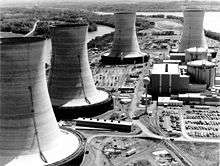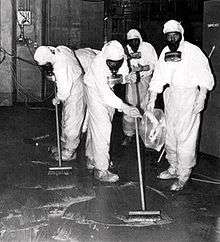Three Mile Island: A Nuclear Crisis in Historical Perspective
 | |
| Author | J. Samuel Walker |
|---|---|
| Subject |
Three Mile Island Nuclear Power Plant (Pa.) Nuclear power plants—Accidents. |
| Publisher | University of California Press |
Publication date | 2004 |
| Pages | 303 |
| ISBN | 0-520-23940-7 |
| 363.17 | |
| LC Class | TK1345.H37 W35 2004 |

Three Mile Island: A Nuclear Crisis in Historical Perspective is a scholarly history of the Three Mile Island accident, written by J. Samuel Walker and published in 2004. Walker is the Nuclear Regulatory Commission's historian and his book is the first detailed historical analysis since the accident.[1]
The 1979 accident at Three Mile Island Nuclear Power Station in Pennsylvania was "the single most important event in the fifty-year history of nuclear power regulation in the United States", according to Walker. Many commentators have seen the event as a turning point for the nuclear power industry in the United States.[2]
Author
Three Mile Island is J. Samuel Walker's fourth book as the official historian of the U.S. Nuclear Regulatory Commission (NRC). In the book's preface, Walker tells readers that he had complete independence in its authorship—that the NRC placed no restrictions on what could be said.[3] However, Walker provides an historical account and does not assess the performance of the NRC.[2]
Background and introduction
The Three Mile Island power station is near Harrisburg, Pennsylvania in the United States. The accident described in Three Mile Island began on Wednesday, March 28, 1979, and ultimately resulted in a partial core meltdown in Unit 2 of the nuclear power plant. Unit 2's pressurized water reactor was of 900 MWe capacity.[4] The scope and complexity of this reactor accident became clear over the course of five days, as a number of agencies at the local, state and federal levels tried to solve the problem and decide whether the ongoing accident required an emergency evacuation, and to what extent.
Walker's objective in Three Mile Island was to write a comprehensive and authoritative history that would serve as an authoritative record for both the interested public and the NRC. The book provides a detailed account of the causes of the accident and the response to it by the NRC, the state of Pennsylvania, and the White House.[5]
The early chapters of Three Mile Island provide historical background for the accident, giving a short overview of the expansion of commercial nuclear power, supported by government, in the 1960s and 1970s. The emerging controversy during that period over nuclear power safety is also examined. The public were concerned about the risk of nuclear accidents and about routine low-level releases of radioactivity.[2]
Analysis


The main part of the book consists of six chapters, with a chapter covering each of the five days (Wednesday, March 28, 1979, to Sunday, April 1, 1979) of the crisis stage of the accident and another chapter covering its immediate effects. Walker draws on a wide range of sources, but mainly on the report of the Kemeny Commission, which President Carter appointed immediately after the accident, and the Rogovin Report, which resulted from the NRC's own inquiry.[2]
The chain of events that led to the crisis at the TMI plant included several minor equipment failures that operator errors drastically compounded, resulting in a major accident.[2][5] The Three Mile Island accident is largely seen as a failure of crisis management.[1] According to one reviewer of the book:
Reactor operators were not trained to deal with accident conditions, and the NRC had not established effective communication with utilities. Moreover, once the accident occurred, the lines of authority proved to be ill defined. The public received conflicting reports that caused needless panic and evacuations. It was these systemic weaknesses in the regulatory system that allowed gifted people to make the mistakes they did.[1]
Large portions of the TMI-2 reactor core melted, though the fact that a meltdown had occurred was not established until 1985. The greatest concern during the TMI accident was a hydrogen bubble in the top of the pressure vessel which held the core:[5]
Although opinions differed, some reactor experts feared that over time the hydrogen bubble might become flammable or, less likely, explosive by combining with free oxygen in the vessel. If the bubble burned or exploded, it could rupture the pressure vessel and force the damaged reactor core into the containment building. The loss of the vessel would not make a breach of containment inevitable, but it would increase the risk of a disastrous release of radioactivity.[5]
In the end, the Three Mile Island accident, though it "caused a grave crisis, did not produce a public health disaster". The pressure vessel held when faced with a core meltdown and there was no breach of the power plant's containment structure. Only "tiny amounts of the most dangerous forms of volatile radiation escaped to the atmosphere".[5] It took 11 years to clean up TMI-2 and this cost about US$1 billion.[2]
Walker suggests that the TMI accident incited widespread criticism of nuclear power technology, the nuclear industry, and the NRC. Critics faulted the industry and the NRC for their poor performance both before and after the accident. The international attention garnered by the crisis redoubled the determination of, and enhanced the credibility of, the anti-nuclear movement. Arguably, the United States nuclear industry has never recovered.[6]
Walker reports that "studies looking for long-term radiation effects resulting from the accident have reached conflicting conclusions", but it seems "that any increase in cancers is slight enough to have occurred by chance".[2]
Conclusions
Walker concludes that the TMI-2 accident left a mixed legacy. It did force regulatory and operational improvements on a reluctant industry, but it also increased opposition to nuclear power. In Walker's analysis, neither the critics nor proponents are completely vindicated. Anti-nuclear advocates were right: a nuclear accident was likely, and the industry was not prepared for it. But their predicted worst-case accident, called the "China Syndrome", did not eventuate. For its part, the industry said that it had reformed itself, but perhaps by then few were listening.[1]
Reception
There have been several published reviews of Three Mile Island. John F. Barber from The University of Texas states that Walker's insightful book captures the "high human drama surrounding the TMI accident", sets it in the context of the contentious debate over nuclear power in the seventies, and discusses the social, technical, and political issues it raised. Walker's authoritative account of the days and events surrounding the TMI accident captures the complexities of the situation, clears up some misconceptions, and discusses the aftermath and implications. According to Barber, Walker provides "thoughtful and sober grounds for the continued debate over the role of nuclear power in our contemporary world".[6]
In a review for Times Higher Education, Jack Harris says that Walker is an extremely good writer and even those who do not specialise in technical fields will derive enjoyment from the book. According to Harris, Walker has unique experience as historian to the NRC which has placed him in an unrivalled position to tell the TMI story. But Harris identifies some omissions in the book. There is little on the other two major nuclear that threatened large civilian populations: the Windscale fire (UK, October 1957), and the Chernobyl disaster (Ukraine, April 1986). Harris states that Windscale threw up similar problems to TMI, particularly relating to whether large-scale evacuations should have been initiated, but he could find no reference to the Windscale accident in the book's index which is surprising in a book that aims to put TMI in historical perspective.[7]
In a review for New Scientist, Rob Edwards states that Walker provides a lucid account of the Three Mile Island accident, which is "riveting because of its detail". It gives a graphic insight into the chaos and confusion of the five-day crisis, and shows how the nuclear industry, the regulators and the government all "initially played down the risks, then had to eat their words".[8] Some 144,000 people were evacuated, but Walker points out that "if the full extent of the core meltdown had been known at the time, hundreds of thousands more would have been told to go". Edwards says a "catastrophe was avoided — but only by luck".[8]
Thomas Wellock from Central Washington University recommended the book "for all libraries and students of politics, government bureaucracy, and environmental history".[1]
Bernard L. Cohen, from the University of Pittsburgh, criticized the book in terms of the scope and quality of its technical content: "The book contains little technical information, and many of the technical explanations that do appear range from inadequate to misleading to incorrect."[9]
See also
- Generation II reactor
- List of books about nuclear issues
- List of civilian nuclear accidents
- Normal Accidents
- Nuclear accidents in the United States
- Nuclear whistleblowers
- Nuclear safety
- Nuclear safety in the U.S.
- Three Mile Island accident health effects
- Three Mile Island: Thirty Minutes to Meltdown
- Robert Del Tredici
References
- 1 2 3 4 5 Wellock, Thomas R. (22 September 2005). "Three Mile Island: A Nuclear Crisis in Historical Perspective (Book review)". The Historian. 67. doi:10.1111/j.1540-6563.2005.00122.x.
- 1 2 3 4 5 6 7 Bernero, Robert M. (November–December 2004). "March Madness (Book review)". American Scientist. 92 (6).
- ↑ Walker, J. Samuel (2004). Three Mile Island: A Nuclear Crisis in Historical Perspective. Berkeley: University of California Press. ISBN 978-0-520-23940-1. pp = ix–x
- ↑ World Nuclear Association (1999). Three Mile Island: 1979 Retrieved December 24, 2008.
- 1 2 3 4 5 Walker, J. Samuel. (March 18, 2009). Documenting Three Mile Island Bulletin of the Atomic Scientists.
- 1 2 Barber, John F. (1 December 2004). "Three Mile Island: A Nuclear Crisis in Historical Perspective (Review)". Leonardo online.
- ↑ Harris, Jack. (August 13, 2004). An explosive past that still shocks to the very core Times Higher Education.
- 1 2 Edwards, Rob (March 20, 2004). "Three Mile Island by J. Samuel Walker". New Scientist.
- ↑ Cohen, Bernard L. (February 2005). "Three Mile Island: A Nuclear Crisis in Historical Perspective (Review)" (PDF). Physics Today. 58 (2): 63–4. doi:10.1063/1.1897526.
External links
- Three Mile Island Accident (NRC Facts Sheet)
- A Nuclear Nightmare
- Annotated bibliography for Three Mile Island from the Alsos Digital Library for Nuclear Issues